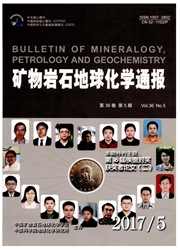

 中文摘要:
中文摘要:
微生物广泛分布在岩石圈、水圈、土壤圈和大气圈中,在矿物风化作用过程中扮演着重要的角色。本文选取门多萨假单胞杆菌(Pseudomonas mendocina)为代表性菌种,研究微生物与含铁蒙脱石矿物相互作用的现象和机理。通过测量反应溶液pH值、元素含量的变化,以及不同时段蒙脱石的XRD和红外光谱等,发现pH值在实验过程中缓慢上升,Si、Al、Fe元素不断溶出,矿物结构特征与主要基团也显示出相应的变化,表明细菌会破坏蒙脱石的晶体结构,并加速蒙脱石的伊利石化作用。根据分析结果推测,硅氧四面体优先被破坏,Si的溶出显著,P.mendocina可同时还原蒙脱石晶格中的Fe3+,并释放至溶液中。
 英文摘要:
英文摘要:
Microorganisms,which distribute widely in lithosphere,hydrosphere,pedosphere and atmosphere,play important roles in weathering processes of minerals and rocks.In this study,Pseudomonas mendocina wass chosen as a representative strain to investigate the phenomenon and mechanism of the interaction between microbe and Fe-containing montmorillonite.The pH value and the element contents of the supernatant was analyzed;the X-ray diffraction spectrum(XRD)and the infrared spectrum(IR)of montmorillonite were measured.The results found that the pH values increased slightly,and that Si,Al and Fe were released continuously.The results also found that the clay structure and surface functional groups were slightly changed,indicating that montmorillonite had been attacked by P.mendocina and presented as an illitization process.According to the analysis results,silico-oxygen tetrahedron tended to be attacked firstly and the dissolution of Si was relatively remarkable.At the same time,P.mendocina was able to reduce Fe3+ in the montmorillonite crystal and thus to release Fe2+ to the solution.
 同期刊论文项目
同期刊论文项目
 同项目期刊论文
同项目期刊论文
 Quantitative X-ray photoelectron spectroscopy-based depth profiling of bioleached arsenopyrite surfa
Quantitative X-ray photoelectron spectroscopy-based depth profiling of bioleached arsenopyrite surfa Tolerance and Biosorption of Heavy Metals by Cupriavidus metallidurans strain XXKD-1 Isolated from a
Tolerance and Biosorption of Heavy Metals by Cupriavidus metallidurans strain XXKD-1 Isolated from a Re-Os isotope dating of pyrite from the footwall mineralization zone of the Xinqiao deposit, Tonglin
Re-Os isotope dating of pyrite from the footwall mineralization zone of the Xinqiao deposit, Tonglin A fluorescence turn-on Hg2+ probe based on rhodamine with excellent sensitivity and selectivity in l
A fluorescence turn-on Hg2+ probe based on rhodamine with excellent sensitivity and selectivity in l Fluorescence turn-on of easily prepared ?uorescein derivatives by zinc cation in water and living ce
Fluorescence turn-on of easily prepared ?uorescein derivatives by zinc cation in water and living ce Analysis of Genes and Proteins in Acidithiobacillus ferrooxidans During Growth and Attachment on Pyr
Analysis of Genes and Proteins in Acidithiobacillus ferrooxidans During Growth and Attachment on Pyr 期刊信息
期刊信息
